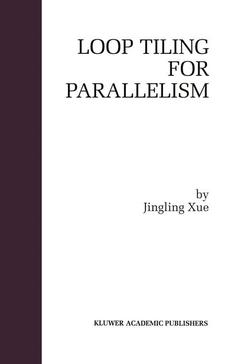Description
Loop Tiling for Parallelism, Softcover reprint of the original 1st ed. 2000
The Springer International Series in Engineering and Computer Science Series, Vol. 575
Author: Jingling Xue
Language: English
Subject for Loop Tiling for Parallelism:
Keywords
algorithms; compiler; distributed memory; optimization; processor
Approximative price 158.24 €
In Print (Delivery period: 15 days).
Add to cart
Loop Tiling for Parallelism
Publication date: 10-2012
256 p. · 15.5x23.5 cm · Paperback
Publication date: 10-2012
256 p. · 15.5x23.5 cm · Paperback
Approximative price 158.24 €
Subject to availability at the publisher.
Add to cart
Loop tiling for parallelism (Kl. intl ser. in engineering and computer science, 575)
Publication date: 08-2000
256 p. · 15.5x23.5 cm · Hardback
Publication date: 08-2000
256 p. · 15.5x23.5 cm · Hardback
Description
/li>Contents
/li>
Loop tiling, as one of the most important compiler optimizations, is beneficial for both parallel machines and uniprocessors with a memory hierarchy. This book explores the use of loop tiling for reducing communication cost and improving parallelism for distributed memory machines. The author provides mathematical foundations, investigates loop permutability in the framework of nonsingular loop transformations, discusses the necessary machineries required, and presents state-of-the-art results for finding communication- and time-minimal tiling choices. Throughout the book, theorems and algorithms are illustrated with numerous examples and diagrams. The techniques presented in Loop Tiling for Parallelism can be adapted to work for a cluster of workstations, and are also directly applicable to shared-memory machines once the machines are modeled as BSP (Bulk Synchronous Parallel) machines.
Features and key topics:
Features and key topics:
- Detailed review of the mathematical foundations, including convex polyhedra and cones;
- Self-contained treatment of nonsingular loop transformations, code generation, and full loop permutability;
- Tiling loop nests by rectangles and parallelepipeds, including their mathematical definition, dependence analysis, legality test, and code generation;
- A complete suite of techniques for generating SPMD code for a tiled loop nest;
- Up-to-date results on tile size and shape selection for reducing communication and improving parallelism;
- End-of-chapter references for further reading.
List of Figures. List of Tables. Preface. Acknowledgments. Part I: Mathematic Background and Loop Transformation. 1. Mathematical Background. 2. Nonsingular Transformations and Permutability. Part II: Tiling as a Loop Transformation. 3. Rectangular Tiling. 4. Parallelepiped Tiling. Part III: Tiling for Distributed-Memory Machines. 5. SPMD Code Generation. 6. Communication-Minimal Tiling. 7. Time-Minimal Tiling. Bibliography. Index.
© 2024 LAVOISIER S.A.S.




